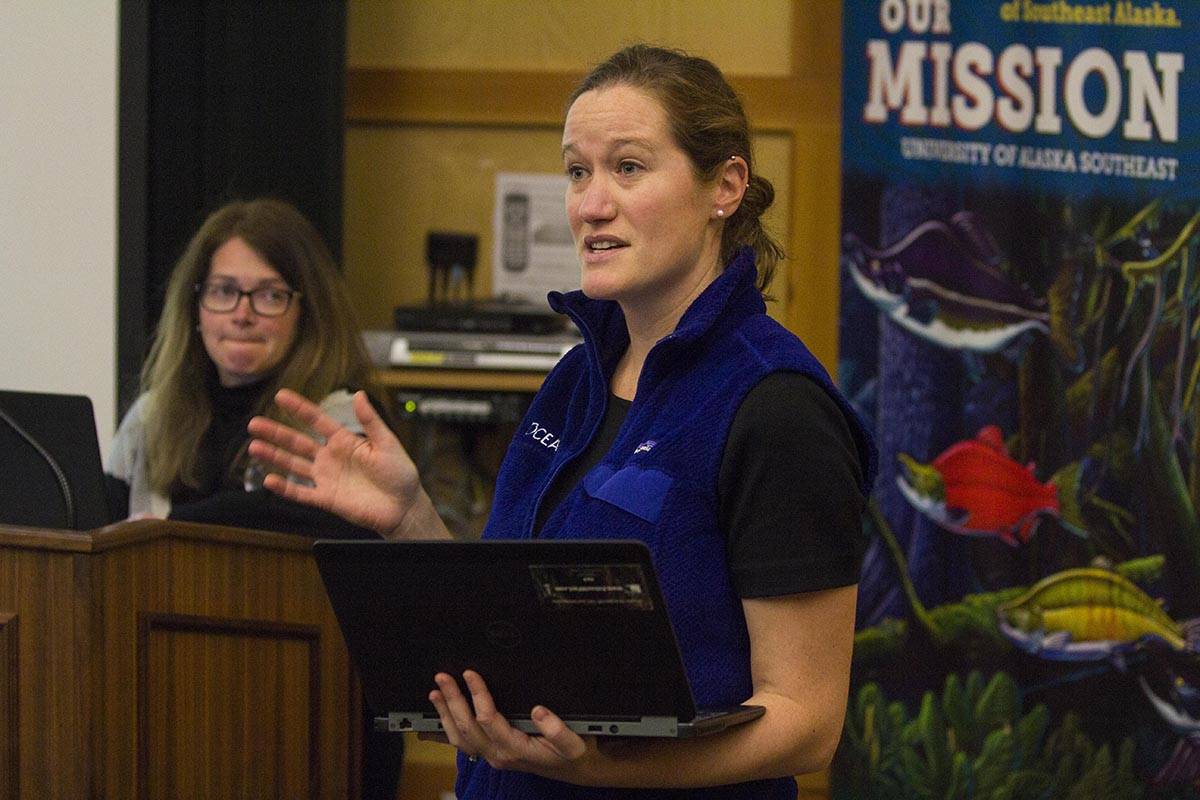NOAA’s fisheries division, the National Marine Fisheries Service, has proposed creating a number of critical habitat sites ranging from the Channel Islands in southern California to the Bering Sea, including the waters off Juneau.
The critical habitats, created with the aim of protecting the feeding areas of three separate groups of humpback whales, or Megaptera novaeangliae, will not affect anything except for federal agencies seeking to use those waters for other purposes, said Lisa Manning, an official with NOAA. Her presentation to the public on the proposed habitats was held at University of Alaska Southeast on Thursday evening, and was attended by more than 30 people.
“A critical habitat does not establish a sanctuary or preserve. It does not affect recreational activities. It does not affect private lands,” Manning said. “It only affects federal activities.”
The proposed habitats, which cover 175,182 square nautical miles in total, are the traditional feeding areas of three of the 14 major humpback whale distinct population segments (DPS), Manning said. The three groups that come to Alaska and California to summer and feed spend the rest of their time west of Mexico, west of Central America and east of Taiwan respectively. These three groups are currently threatened, and protecting their feeding areas may help them to regain their footing, Manning said. Some of these groups may number 2,000 whales or less.
[Four whales struck by vessels this year in Southeast]
“While we’ve seen some success with our other DPS but we don’t want these ones to get forgotten,” said Molly Zaleski, a marine scientist with ocean advocacy group Oceana during the public comment period.
Whales migrate north to feed on euphausiids and small fish to support population growth, Manning said during the presentation. The idea of the critical habitat designation is to limit the effects of climate change, direct harvest of prey in commercial fisheries, ocean noise, and pollution created by federal agencies or federal actions.
Several sections of the proposed critical habits were excluded, including the region outside Anchorage, the ocean off of Los Angeles, the Southeast Alaska Acoustic Measurement Facility near Ketchikan and the Quinault Range Site in Washington. The two Navy sites will continue on as usual, Manning said.
“It makes sense ecologically and it makes sense economically,” Zaleski said during the public comment time, referring to the amount of carbon each whale ties up and their place in the food web, as well as the tourism whales generate through whale-watching tours. “Each large whale is worth about 2 million dollars to us. They have a lot of value to us.”
Not everyone agreed. Doug Vincent-Lang, the commissioner of the Alaska Department of Fish and Game, also gave public comment.
[7 dead whales reported on Kodiak Island in 2018]
“We’re disappointed the NMFS didn’t consult with Alaska (Department of) Fish and Game,” Vincent-Lang said. “These are large documents, and we’ve identified multiple fundamental flaws with your proposal that will take significant time to resolve.”
Vincent-Lang said that policies in Alaska had been successful in helping humpback populations in the region to rebound from the edge, and expressed doubts that the designated critical habits would have much positive effect.
“Portions of these areas are not even known humpback feeding grounds,” Vincent-Lang said. “We requested but were denied the opportunity to review the document.”
Make your voice heard
To look at the rule or comment for the file, check out the regulation here.
• Contact reporter Michael S. Lockett at 757-621-1197 or mlockett@juneauempire.com.

